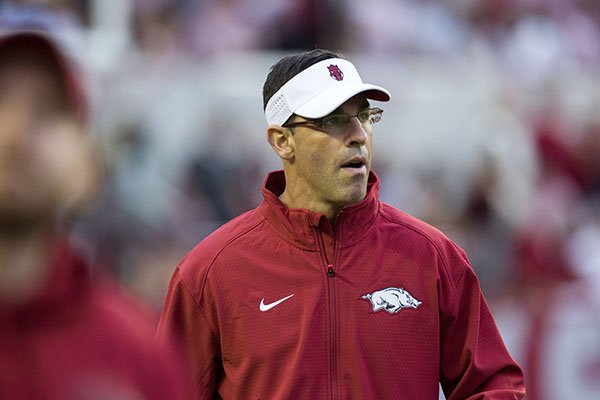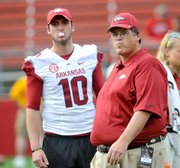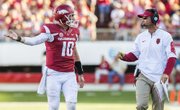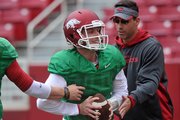One of Dan Enos’ first teaching points with Brandon Allen centered on getting his senior quarterback to stop patting the football so much when he dropped back to pass.
The pointer was simple. Minute, even. Yet it encapsulated the attention to detail and feel for coaching the position Enos brought with him to Fayetteville as he morphed Arkansas from a power-running offense that shied away from obvious passing situations, to a high-powered attack with the ability to run and pass equally effectively and take advantage of mismatches.
The offensive overhaul from year two of the Jim Chaney era to the first season of Enos’ tenure as Arkansas’ offensive coordinator was impressive, to say the least. In 2014, Chaney’s final year with the program, the Razorbacks won three of their final four games off the strength of a physical, veteran defense that pitched back-to-back shutouts against top-20 foes and allowed seven points per outing during the stretch. Last year, Arkansas won six of its final seven games with a porous defense giving up an average of 26.9 points in regulation. The offense was so good, the Hogs won in spite of their defensive shortcomings.
In one year under Enos, Allen went from a scapegoat who, along with his truck, was cruelly mistreated by the loony fringe of Arkansas’ fan base to a hometown hero and sixth-round NFL draft pick, an impressive transformation given Enos was Allen’s fourth offensive coordinator in five years. Much has been made of Enos having played the position and thus having a better feel for coaching it than Chaney, a nose tackle in college. It’s hard to ignore that, given the differing results Allen produced playing under the two.
"We think alike," Allen said of Enos last year. "We see things kind of the same on the sideline, what the defense is doing. It's been really great. We've really kind of meshed well, especially down the stretch and I couldn't ask for a better coach to be coaching me."
Enos’ next task is turning a second Allen into a top-flight SEC quarterback. Barring the unforeseen, he’ll spend three years tutoring Austin Allen by the time he graduates following the 2017 campaign.
After seeing his ability to turn around an offense and its quarterback in less than 12 months, there has to be a sense of confidence around the Fred W. Smith Center that Enos will summon the best version of Austin Allen. His track record at Central Michigan and last season at Arkansas indicates the Razorbacks will get good quarterback tutoring as long as he’s standing on the sidelines in Razorback Stadium.
The differences between Arkansas’ offense in 2014 (Chaney) and 2015 (Enos) were clear to even the most casual observer, but the basics warrant repeating. In 2014, Arkansas threw the ball on 39 percent of its offensive snaps, with Allen throwing for 2,285 yards, 20 touchdowns and five interceptions. That 39 percent was basically the same in Allen’s sophomore season, also under Chaney.
Last year, Arkansas threw the ball on 42 percent of its offensive snaps, a slight but noticeable uptick. The Razorbacks also threw the ball on 31.5 percent of first downs under Enos, compared to 27 percent under Chaney. Allen had a career year, passing for 3,440 yards, 30 touchdowns and eight picks.
That’s a massive leap — 1,115 extra yards and 10 more touchdowns — on only 31 extra attempts in Allen’s senior year. He was a different quarterback.
Arkansas had 96 completions of 15 or more yards in Allen’s senior year, including 31 that were 25 yards or longer. By comparison, his junior year featured just 60 passes of 15-plus yards and 18 of 25 or more. But Allen didn’t suddenly evolve into a deep-ball extraordinaire, even though that aspect of his game was improved. In reality, the senior version of Allen threw more short passes that went for longer gains than in any previous incarnation of the offense.
Arkansas’ offensive identity was still as a run-first team at its essence, but the pass became a much more dangerous weapon under Enos and allowed Arkansas to achieve his definition of offensive balance: the ability to attack the defense in whatever way is most effective, run or pass. For the first time in the Bielema era, the Razorbacks could throw when needed, evidenced by the Ole Miss win and Mississippi State loss, games in which Allen combined to throw for 848 yards, 13 touchdowns and no interceptions as the Razorbacks scored a combined 103 points.
The obvious caveat is the natural progression Allen and Co. would’ve made regardless of who the coordinator was, just as a result of the extra year of experience. Dominique Reed’s addition to the stable of receivers gave Allen and Enos a home-run weapon Chaney didn’t have at his disposal. Jonathan Williams’ injury forced Arkansas to come to terms with the necessity of being able to be more balanced (not that Enos’ impact would’ve been lessened or Arkansas wouldn’t have had the ability to be balanced had Williams not injured his foot).
But the overriding theme of Enos’ first season was his ability to 1) call wholly different games week-to-week predicated on matchups and 2) put his players in great positions on the field to succeed.
Bielema’s pep talk in the mid-October bye week emboldened Enos’ playcalling and served as a turning point for the season, with the Razorbacks noticeably more aggressive on offense the remainder of the year.
“I referred to it as let's take a swing rather than not,” Bielema said last season. “I'd rather know we attacked than held back."
With that in mind, let’s compare and contrast Arkansas’ offensive output in SEC West games from the past two years for a case study. Four of last year’s games occurred after the bye. Overall, West games make up half of the regular season slate and feature much of the stiffest competition the Razorbacks face.
Allen completed 65.6 percent of his passes and threw for 1,622 yards, 20 touchdowns and four interceptions in the six-game slugfest as a senior. He averaged 12.9 yards per completion, up from 11.5 his junior year, when he competed 54.5 percent while throwing for 1,114 yards, five touchdowns and three interceptions against the same competition.
Enos routinely displayed his creativity as a playcaller, finding avenues to get the ball to playmakers in space in ways that fit each players’ skill set and preyed on defensive issues, whether it was run-pass options and frequent bubble screens to capitalize on mismatches and alignment advantages on the edge, Reed’s increased production and varied targets as the season progressed, Drew Morgan, unproductive under Chaney, repeatedly burning defenses on drag routes or finding new ways to spring Hunter Henry for his best season in cardinal and white despite opposing defenses knowing they needed to key on the best pass-catching tight end in college football.
There was some carryover from Chaney’s offense to Enos’ in that Enos retained most of the run-game terminology from his predecessor. But the passing game “pretty much changed 100 percent as far as what we called the routes and the structures,” Enos told the Florida Times-Union.
The result? Space for playmakers. Against West foes as a senior, nearly 61 percent of Allen’s attempts were on throws that traveled less than 10 yards down the field (he completed 69 percent of those passes while throwing 11 touchdowns and no interceptions). Many of Arkansas’ big plays in the passing game came on short completions in space that allowed the receiver to turn upfield and gash opposing defenses for yards after the catch.
“The nuances and details of each route, the way he taught us the routes helped us improve the passing game,” tight end Jeremy Sprinkle said.
By comparison, only 56 percent of Allen’s passes against West foes in 2014 were on attempts of fewer than 10 yards. He completed fewer of the short throws (67 percent) and averaged less yards per completion in that department as a junior — his receivers had less opportunity to make plays after the catch. The flip side of that is he attempted more intermediate and long throws in Chaney’s system, even though he was skittish at times when faced with a pass rush.
That’s another aspect of Allen’s game that improved as a senior. When he did throw the ball down the field, he routinely displayed the ability to maintain his base and stand in the pocket under duress, another Enos teaching point, while delivering strikes to receivers who found openings in the coverage. In the six games against West opponents in 2015, he completed 66 percent of his passes with five touchdowns and two picks on throws traveling 10 to 19 yards downfield and 45 percent with four touchdowns and two interceptions on throws of 20 yards or more.
Those numbers are a far cry from 2014, when he was just 45 percent with two touchdowns and two interceptions in the 10-19 range and a woeful 26 percent with two touchdowns and an interception on throws that traveled 20 yards or farther. Two years, two vastly different players, with Enos’ Allen being unquestionably superior.
Perhaps nothing symbolizes Enos’ ability to adapt to week-to-week matchups like Arkansas’ three-game stretch against Ole Miss, LSU and Mississippi State last November.
Against Ole Miss, Arkansas combatted the Rebels’ dangerous pass rush by moving the pocket on a regular basis, with Allen finishing 5 of 7 for 69 yards and two touchdowns on bootlegs or waggles. As a whole, Allen completed 33 of 45 passes for 442 yards and six touchdowns in Arkansas’ thrilling 53-52 win, made possible by the unforgettable fourth-and-25 OT conversion. Side note: How much more thrilling would the moment be if the TV call had been anything but pathetic? Going back and watching film months after the season drove home how devoid of emotion (and comprehension) the call was. Anyways, Allen was only sacked once against Ole Miss.
In addition to moving the pocket, Allen got the ball out of his hand quickly against the Rebels, completing 21 of 28 passes on throws that traveled less than 10 yards. Arkansas also kept the pass rush at bay by frequently using play action, resulting in Allen completing 17 of 22 for 267 yards and all six of his touchdowns off play fakes.
The next week, Arkansas quickly built a 21-0 lead at No. 9 LSU and Enos rode the run game, which churned out 299 yards and 7.5 yards per carry, to victory. Still, he kept the Tigers off balance with misdirection, including Jared Cornelius’ 69-yard touchdown jaunt on an end around.
Arkansas took full advantage of a Mississippi State defense that wound up finishing 10th in the SEC in passing yards allowed and 11th in passing efficiency defense the following week, a 51-50 Razorback loss but a game which may go down as Allen’s best. Arkansas had trouble blocking Mississippi State’s interior line throughout, but again used a heavy dose of play action to try to buy Allen time. He completed 18 of 23 for 275 yards and all of his career-high seven touchdowns off play fakes, part of his 30 of 43 for 406-yard performance. When he had time, Arkansas attacked the shaky Mississippi State secondary down the field, giving Allen a stage to showcase the best deep-ball performance of his career. He completed 13 of his 16 throws from 10 to 19 yards for two touchdowns and hit on two of his five throws that were 20 or more yards with another touchdown.
Enos was unpredictable as a playcaller from week-to-week, but he used Arkansas’ historic strength — it’s rushing attack — as a weapon in the pass game much more frequently than Chaney did. Against West foes, more than 43 percent of Arkansas’ passing plays in 2015 (including sacks and scrambles) came off play action, a sizeable jump from 34 percent under Chaney in 2014. When Arkansas faced its stiffest competition, Enos made a concerted effort to keep defenses off balance, which resulted in Arkansas averaging 8.9 yards per play-action snap with Allen sporting a gaudy 16-1 touchdown to interception ratio. The Razorbacks were less effective in 2014, averaging 5.7 yards per snap with four touchdowns.
“Just being able to set up the play-action game helped us get those extra catches,” Sprinkle said.
From a pre-snap standpoint, Chaney’s offense often looked sexier than Enos’ — the Hogs lined up in the shotgun on 32.4 percent of its snaps against West foes in 2014 and featured three receivers on nearly 23 percent of their snaps.
Enos, on the other hand, only operated from the shotgun on 23 percent of snaps and featured three receivers less than 20 percent of the time against like opponents. But Enos’ approach was markedly more effective and better fit his personnel.
More than 42 percent of shotgun snaps featured only two receivers under Enos. Most of those looks were two tight ends with Henry and Sprinkle creating matchup nightmares for bewildered defenses across the field.
“Coach Enos installed a lot of different passing concepts that are favorable to the tight end and just favorable to our play-action game,” Sprinkle said.
On the other hand, Chaney featured three receivers on the vast majority, more than 70 percent, of his shotgun snaps, despite having AJ Derby along with Henry and Sprinkle at tight end, coupled with a then-underwhelming receiving corps.
The receivers’ struggles in 2014 made them a huge question mark entering last season, one that became even bigger after the group endured injury after injury early in the year. But Enos transformed them into one of the better units in the conference by putting them in a position to succeed while still simultaneously featuring Arkansas’ wealth of talent at tight end to create mismatches for opposing defenses.
Brandon Allen’s transformation into a clutch gun-slinger late in his senior season was enamoring to watch unfold. Austin Allen doesn’t have his brother’s game experience or Hunter Henry. But he is entering year two with Dan Enos.
It’s pretty clear that’s a major positive.




